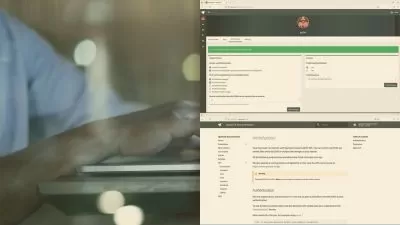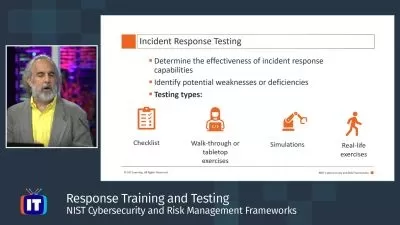Associate Professional Risk Manager (APRM) Certification
YouAccel Training
19:56:15
Description
Master Risk Management Essentials and Earn Your Certified Associate Professional Risk Manager Credential
What You'll Learn?
- Key principles of risk management: Understanding the foundational concepts and strategies that guide effective risk management across industries.
- Types of risks: Identifying and analyzing different forms of risks such as financial, operational, market, and credit risks.
- Risk management frameworks: Exploring widely used frameworks like ISO 31000, COSO ERM, and NIST for managing organizational risks.
- Roles and responsibilities in risk management: Learning how senior leadership, boards, and risk officers contribute to implementing and overseeing risk strategi
- Risk and return theory: Applying concepts such as Modern Portfolio Theory (MPT), Capital Asset Pricing Model (CAPM), and Efficient Market Hypothesis (EMH) to ba
- Portfolio risk management: Understanding diversification strategies and the risk-return trade-off to develop resilient investment portfolios.
- Corporate risk management techniques: Learning to implement internal risk controls, risk identification, and mitigation strategies within corporate settings.
- Financial regulation and compliance: Understanding regulatory frameworks such as Basel III and how they influence corporate risk governance.
- Market risk management: Analyzing and managing risks associated with interest rates, foreign exchange, and commodity prices in financial markets.
- Asset-liability management (ALM): Gaining insights into liquidity risk, interest rate sensitivity, and ALM performance metrics in banking and financial institut
- Operational risk management: Identifying risks in processes, systems, and technologies and learning strategies to mitigate risks such as fraud and human error.
- Stress testing and scenario analysis: Understanding how stress tests and scenario analysis help organizations prepare for and respond to crises.
- Emerging risks: Identifying and managing emerging risks such as cybersecurity threats, climate change, and geopolitical risks.
- Ethics in risk management: Exploring ethical considerations and professional standards in risk decision-making and promoting an ethical risk culture.
- Risk governance principles: Understanding the role of governance in ensuring effective risk communication and oversight at senior management levels.
- Tools for managing market risk: Learning about tools and techniques used to manage exposure to market volatility and mitigate financial losses.
Who is this for?
What You Need to Know?
More details
DescriptionRisk management plays a critical role in today’s business environment, helping organizations navigate uncertainties and protect their assets. This course provides a thorough examination of the principles and methodologies that underpin effective risk management across industries. It equips students with the knowledge needed to assess and mitigate various types of risks, such as financial, operational, and market risks. By examining these risks in detail, students will gain a solid understanding of how to apply key risk management strategies in diverse business scenarios.
The course begins with an exploration of the key principles of risk management, emphasizing how organizations can adopt structured approaches to safeguard their operations and ensure long-term sustainability. Students will study various types of risks, including credit, market, and operational risks, and learn how these factors influence business decisions. The focus on real-world applications ensures that students can appreciate how these risks manifest in everyday corporate activities.
In addition to understanding different types of risks, students will delve into widely accepted frameworks used by businesses to manage risk. Models such as ISO 31000, COSO ERM, and NIST are explored in detail, providing students with the tools to apply these frameworks in practical contexts. The course also covers the roles and responsibilities of senior leadership in overseeing risk management, highlighting the strategic importance of risk management within organizational structures.
Another key area covered is the relationship between risk and return. Students will learn how to measure risk in investment portfolios and apply concepts like Modern Portfolio Theory (MPT), the Capital Asset Pricing Model (CAPM), and the Efficient Market Hypothesis (EMH). These tools help students understand how risk and return are balanced in investment decisions. By studying risk-return trade-offs and diversification strategies, students will develop the ability to create resilient portfolios that minimize potential losses.
Corporate risk management is another significant component of the course. It explores internal risk controls and mitigation techniques tailored to corporate settings, with particular attention to risks posed by cybersecurity threats, supply chain disruptions, and operational inefficiencies. Students will learn to assess these risks using structured methods and implement strategies to mitigate them effectively.
The course also offers a comprehensive overview of financial market risks, including interest rate risk, foreign exchange risk, and commodity price risk. Students will explore how financial institutions manage these risks using sophisticated tools and strategies. Additionally, the section on asset-liability management (ALM) provides insights into liquidity risk, interest rate sensitivity, and the metrics used to gauge ALM performance in banking and financial services.
Operational risk management is addressed by exploring the risks inherent in business processes and technologies. This section emphasizes the importance of managing human error and fraud, as well as the growing role of technology in risk mitigation. By understanding these challenges, students will be better equipped to implement solutions that safeguard organizations from internal and external threats.
The course also prepares students to handle emerging risks, such as those posed by cybersecurity, climate change, and geopolitical instability. As businesses face increasingly unpredictable environments, the ability to anticipate and respond to new threats is vital. The course encourages students to think strategically about risk, equipping them with the foresight needed to manage emerging challenges.
Finally, ethical considerations in risk management are explored, ensuring that students understand the importance of professional conduct and integrity in decision-making. By promoting an ethical risk culture, organizations can enhance both their internal operations and external reputation.
Overall, this course provides a deep understanding of risk management strategies and frameworks, helping students develop a robust theoretical foundation. Through detailed analysis and critical thinking, students will be prepared to lead in roles that require advanced risk management skills.
Who this course is for:
- Aspiring risk management professionals: Individuals looking to build a foundational understanding of risk management principles and frameworks to start a career in risk management.
- Business leaders and executives: Decision-makers who need to understand risk strategies to protect their organizations and make informed strategic decisions.
- Financial professionals: Those working in banking, investment, or financial services seeking to enhance their knowledge of risk in financial markets, asset-liability management, and portfolio risk strategies.
- Corporate governance and compliance officers: Professionals responsible for ensuring regulatory compliance and managing corporate risks, particularly in relation to financial regulations like Basel III.
- Operational managers: Individuals in charge of managing risks in day-to-day processes, technology, and cybersecurity, looking to improve their operational risk management skills.
- Students of finance and business: Learners pursuing degrees in finance, business, or economics who want to deepen their theoretical knowledge of risk management and its applications across industries.
- Consultants and advisors: Risk management consultants or business advisors who need to strengthen their expertise in risk frameworks and strategies to provide more comprehensive solutions to their clients.
Risk management plays a critical role in today’s business environment, helping organizations navigate uncertainties and protect their assets. This course provides a thorough examination of the principles and methodologies that underpin effective risk management across industries. It equips students with the knowledge needed to assess and mitigate various types of risks, such as financial, operational, and market risks. By examining these risks in detail, students will gain a solid understanding of how to apply key risk management strategies in diverse business scenarios.
The course begins with an exploration of the key principles of risk management, emphasizing how organizations can adopt structured approaches to safeguard their operations and ensure long-term sustainability. Students will study various types of risks, including credit, market, and operational risks, and learn how these factors influence business decisions. The focus on real-world applications ensures that students can appreciate how these risks manifest in everyday corporate activities.
In addition to understanding different types of risks, students will delve into widely accepted frameworks used by businesses to manage risk. Models such as ISO 31000, COSO ERM, and NIST are explored in detail, providing students with the tools to apply these frameworks in practical contexts. The course also covers the roles and responsibilities of senior leadership in overseeing risk management, highlighting the strategic importance of risk management within organizational structures.
Another key area covered is the relationship between risk and return. Students will learn how to measure risk in investment portfolios and apply concepts like Modern Portfolio Theory (MPT), the Capital Asset Pricing Model (CAPM), and the Efficient Market Hypothesis (EMH). These tools help students understand how risk and return are balanced in investment decisions. By studying risk-return trade-offs and diversification strategies, students will develop the ability to create resilient portfolios that minimize potential losses.
Corporate risk management is another significant component of the course. It explores internal risk controls and mitigation techniques tailored to corporate settings, with particular attention to risks posed by cybersecurity threats, supply chain disruptions, and operational inefficiencies. Students will learn to assess these risks using structured methods and implement strategies to mitigate them effectively.
The course also offers a comprehensive overview of financial market risks, including interest rate risk, foreign exchange risk, and commodity price risk. Students will explore how financial institutions manage these risks using sophisticated tools and strategies. Additionally, the section on asset-liability management (ALM) provides insights into liquidity risk, interest rate sensitivity, and the metrics used to gauge ALM performance in banking and financial services.
Operational risk management is addressed by exploring the risks inherent in business processes and technologies. This section emphasizes the importance of managing human error and fraud, as well as the growing role of technology in risk mitigation. By understanding these challenges, students will be better equipped to implement solutions that safeguard organizations from internal and external threats.
The course also prepares students to handle emerging risks, such as those posed by cybersecurity, climate change, and geopolitical instability. As businesses face increasingly unpredictable environments, the ability to anticipate and respond to new threats is vital. The course encourages students to think strategically about risk, equipping them with the foresight needed to manage emerging challenges.
Finally, ethical considerations in risk management are explored, ensuring that students understand the importance of professional conduct and integrity in decision-making. By promoting an ethical risk culture, organizations can enhance both their internal operations and external reputation.
Overall, this course provides a deep understanding of risk management strategies and frameworks, helping students develop a robust theoretical foundation. Through detailed analysis and critical thinking, students will be prepared to lead in roles that require advanced risk management skills.
Who this course is for:
- Aspiring risk management professionals: Individuals looking to build a foundational understanding of risk management principles and frameworks to start a career in risk management.
- Business leaders and executives: Decision-makers who need to understand risk strategies to protect their organizations and make informed strategic decisions.
- Financial professionals: Those working in banking, investment, or financial services seeking to enhance their knowledge of risk in financial markets, asset-liability management, and portfolio risk strategies.
- Corporate governance and compliance officers: Professionals responsible for ensuring regulatory compliance and managing corporate risks, particularly in relation to financial regulations like Basel III.
- Operational managers: Individuals in charge of managing risks in day-to-day processes, technology, and cybersecurity, looking to improve their operational risk management skills.
- Students of finance and business: Learners pursuing degrees in finance, business, or economics who want to deepen their theoretical knowledge of risk management and its applications across industries.
- Consultants and advisors: Risk management consultants or business advisors who need to strengthen their expertise in risk frameworks and strategies to provide more comprehensive solutions to their clients.
User Reviews
Rating
YouAccel Training
Instructor's Courses
Udemy
View courses Udemy- language english
- Training sessions 181
- duration 19:56:15
- Release Date 2024/11/21










